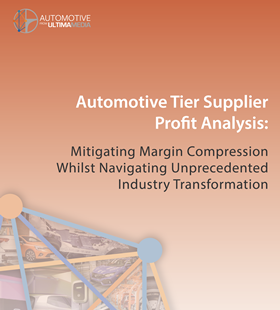Changing supplier business models will influence car design
A squeeze on automotive suppliers, together with the adaptation of new technology, will lead some major players to play a bigger role in overall vehicle design and in shaping customer user experiences

At first glance, there does not appear to be much of a link between car design and the relative profitability of automotive tier 1 suppliers. However, rising costs and pressure on margins are transforming the business models of major global suppliers – with many putting a greater focus on data, software and a variety of design services alongside traditional hardware and engineering.
In our report analysing the profit margin development and business strategies of the top 20 global automotive suppliers, we found a trend among some companies to mitigate declining profit margins by attempting to capture more value across the development cycle. That includes transitioning more to ‘full service’ supplier relationships, such as ‘build to suit’ processes with automotive OEMs, alongside more standard ‘build to print’ services. (Download the full report here).
In these scenarios, tier 1s are not just reactively supplying individual components according to OEM demand and pre-defined specifications, but pro-actively designing and engineering parts, modules or even complete vehicles, whether in vehicle packaging, interior HMI experience, exterior features, prototypes or production vehicles.
Design concepts and services are not new among automotive suppliers, with the likes of Magna and Faurecia known to create prototypes and play significant roles in turnkey product offerings.
However, the unstoppable rise of electronics, sensors, software and mixed materials in vehicles is increasingly providing opportunity for suppliers not only to develop and bring together components for manufacture and delivery, but also to shape vehicle platforms, exterior forms, interiors and infotainment. The march toward autonomous vehicles makes this even more likely.
Evidence of this shift was highly evident at this year’s CES, where electronic giant Sony revealed its Vision S electric vehicle concept. Not only was the concept a sign that Sony is set to play a larger role in the automotive value chain, but it also showed how suppliers will be critical in supporting such new players. The prototype, which was remarkable for being so production ready, was designed and built by Magna, with supporting roles by many other suppliers including Benteler.
The shift towards electrification is also leading more suppliers to take on engineering and design solutions. Some tier 1 suppliers are developing more turnkey powertrain solution rather than the traditional drivetrain being sourced from a multitude of different suppliers. This is not only a module service but can also play key roles in designing and engineering vehicle platforms, with significant influence on vehicle design. Magna, for example, had earlier been closely involved in engineering vehicles at China’s Qoros and Vietnam’s VinFast.
Who controls the value chain?
Our analysis suggests that pressure on costs and margins is likely to lead to more joint ventures and alliances especially in hybrid and EV development. The outcome of this consolidation will ultimately lead to more standard platforms shared across OEMs. This will be part of a trend in which hybrid and EV powertrain technology is gradually commoditised to the point where the platform and drivetrain become a rolling canvas upon which design teams can unleash their vision.
As powertrains and platforms become uniform, the vehicle, branding and sales success will therefore be determined less by the performance or reliability of the mechanics, and defined more by automotive design and customer experiences. That will be a rich space for suppliers.
Another sign of this can perhaps be glimpsed in the early discussions of a new joint venture between FCA and Hon Hai – a division of Foxconn which produces iPhones – to develop and build electric vehicles in China. The smartphone manufacturer has already suggested it would be responsible for design, supply chain and components, and not vehicle assembly. It would seem that Hon Hai has grasped that design will be an area where it can capture significant value compared to manufacturing. We expect more suppliers to think the same.




